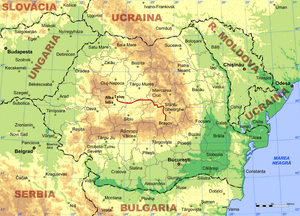Teiuș – Brașov railway line
The Teiuș – Brașov railway is a main line in Romania . It runs mainly in the valleys of the rivers Târnava Mare ( Great Kokel ) and Olt ( Alt ) through parts of the (formerly) German settlement areas in Transylvania .
history
At the time the railway line described here was built, Transylvania belonged to the Kingdom of Hungary . In 1868 the first railway line to Transylvania ( Arad – Alba Iulia ) was built. Most of the larger cities in Transylvania, however, still had no rail links.
In 1868 the Hungarian state began building several lines in Transylvania, but a short time later handed the work over to a private English company. First in November 1871 from Alba Iulia a line through the valley of the Mureș to Târgu Mureș was put into operation. The railway to Brașov (German Kronstadt , Hungarian Brassó ) was built from the Teiuș station (Hungarian Tövis ) . The section from Teiuş to Mediaş (German Mediasch , Hungarian Medgyes ) was opened on May 6, 1872, from Mediaş to Sighişoara (German Schäßburg , Hungarian Segesvár ) on July 8, 1872. On June 1, 1873, the entire route to Brașov was open to traffic.
Due to financial difficulties, the Hungarian state had to support the private consortium several times; In 1876 the company was finally nationalized and taken over by MÁV .
After the end of the First World War , Transylvania and with it the railway line became part of Romania.
Current situation
The entire line is double-track and electrified with alternating current (25 kV, 50 Hz). It is heavily frequented by both passenger and freight traffic.
The Teiuș / Coșlariu (and from Simeria) - Sighișoara line is to be modernized by 2015 as part of the European Transport Corridor IV. This is estimated at 1 billion euros. Passenger trains should then travel 160 km / h and freight trains 120 km / h. (In 2014, work on the entire Teiuș / Coșlariu – Sighișoara section was in full swing.)
In addition, the Coșlariu – Sighișoara line is to be equipped with the ETCS Level 2 train protection system . At the end of 2014, the infrastructure operator CFR-SA commissioned Alstom , Alcatel-Lucent and Pas 97 Impex to equip the 170 km Simeria – Coșlariu – Sighișoara line to increase the maximum speed from 120 km / h to 160 km / h. The order value is around 500 million lei .
In 2019 and 2020, contracts were awarded to expand the Sighișoara – Cața, Cața – Apața and Apața – Brașov sections. The costs of upgrading the 130 km long sections to increase the maximum speed to 160 km / h and equipping the line with ETCS amount to around 616 million euros, of which around 82% Connecting Europe Facility and 18% Romania should take over.
Individual evidence
- ↑ a b On the railway history of the Alps-Danube-Adriatic region, ( Memento from December 20, 2012 in the web archive archive.today )
- ↑ CFR website, accessed on April 13, 2009 ( Memento of August 7, 2007 in the Internet Archive )
- ↑ Mediaș online, ( Memento from January 27, 2007 in the Internet Archive )
- ↑ CFR website, accessed on April 13, 2009 ( Memento from June 28, 2008 in the Internet Archive )
- ↑ Promisiuni solemne: Reabilitarea caii ferate din Medias si modernizarea DN 14, Sibiu - Medias - Sighisoara ( Memento from May 24, 2014 in the Internet Archive ). Retrieved July 17, 2011.
- ↑ Transylvanian ETCS Level 2 contract awarded. Railway Gazette, November 26, 2014, accessed December 11, 2015 .
- ↑ Rehabilitation of Apata - Cata subsection, assigned to a Turkish consortium. In: railwaypro.com. January 25, 2019, accessed August 4, 2020 .
- ↑ CFR SA signs EUR 620 million modernization contract. In: railwaypro.com. March 5, 2020, accessed August 4, 2020 .


